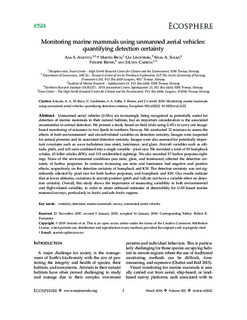| dc.description.abstract | Unmanned aerial vehicles (UAVs) are increasingly being recognized as potentially useful for detection of marine mammals in their natural habitats, but an important consideration is the associated uncertainties in animal detection. We present a study based on fi eld trials using UAVs to carry out image- based monitoring of cetaceans in two fjords in northern Norway. We conducted 12 missions to assess the effects of both environmental- and aircraft-related variables on detection certainty. Images were inspected for animal presence and its associated detection certainty. Images were also assessed for potentially impor- tant covariates such as wave turbulence (sea state), luminance, and glare. Aircraft variables such as alti- tude, pitch, and roll were combined into a single variable — pixel size. We recorded a total of 50 humpback whales, 63 killer whales (KW), and 118 unidenti fi ed sightings. We also recorded 57 harbor porpoise sight- ings. None of the environmental conditions (sea state, glare, and luminance) affected the detection cer- tainty of harbor porpoises. In contrast, increasing sea state and luminance had negative and positive effects, respectively, on the detection certainty of humpback and KW. The detection certainty was not sig- ni fi cantly affected by pixel size for both harbor porpoises, and humpback and KW. Our results indicate that at lower altitudes, variations in aircraft position (pitch and roll) do not have a variable effect on detec- tion certainty. Overall, this study shows the importance of measuring variability in both environmental and fl ight-related variables, in order to attain unbiased estimates of detectability for UAV-based marine mammal surveys, particularly in Arctic and sub-Arctic regions. | |
